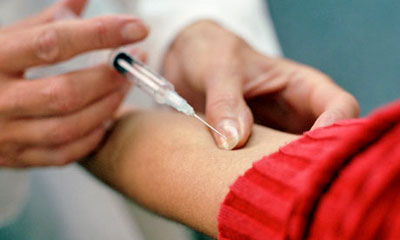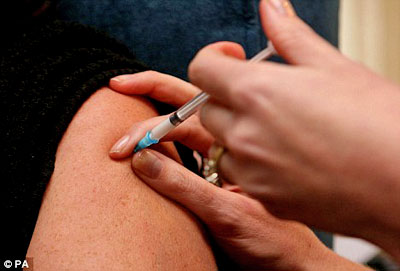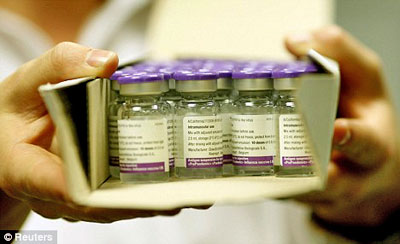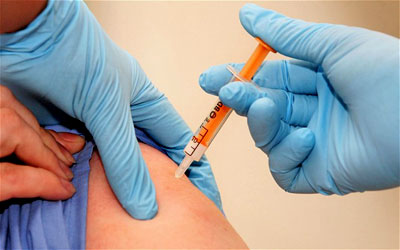|

by Ian Sample
science correspondent
28 March 2012
from
Guardian Website
|
Investigation centers on Pandemrix vaccine used
extensively during 'swine flu' pandemic in 2009/10 |

British health officials are investigating whether a steep rise in
narcolepsy
in other countries is
linked to a specific flu vaccination
Photograph: Alamy
British health officials
are investigating cases of narcolepsy in children amid concerns that
pandemic flu vaccinations lie behind a rise in the sleep disorder
seen in other countries.
The
Health Protection Agency is
gathering vaccination histories and medical data on children aged
four to 18 who have been assessed for narcolepsy at sleep centers in
England in the past few years.
The investigation centers on the GlaxoSmithKline (GSK)
vaccine Pandemrix, which was given
extensively in 2009/10 during
the H1N1 "swine flu" pandemic that
spread around the world.
The vaccine was used very little in 2010/11 and was unavailable
during the 2011/12 influenza season. Pandemrix is only used to
combat pandemics and differs from the more familiar seasonal flu
vaccine.
The HPA said:
"There is no
evidence of any association between seasonal influenza vaccines
and narcolepsy."
Clinical details
including dates of first symptoms and diagnoses are being obtained
from clinics and GP records checked for dates of any pandemic
vaccination given to the children.
The information will help the HPA identify how many children and
teenagers with narcolepsy received the pandemic vaccine and spot any
clustering of the disorder shortly after vaccination. The findings
from the HPA study are due to be published later this year, the
agency said.
The latest evidence for a link between Pandemrix and narcolepsy
appears in two studies from Finland published in the
journal Plos One.
The authors of the papers,
Markku Partinen of the
Helsinki Sleep Clinic and
Hanna Nohynek of the
National Institute for Health and Welfare in Finland, found
narcolepsy in children under 17 averaged from 0.31 cases per 100,000
between 2002 and 2009, but rose 17-fold to 5.3 cases per 100,000 in
2010, when Pandemrix was used.
Further work revealed that in children born between January 1991 and
December 2005 narcolepsy rates for those who had Pandemrix jabs were
nine per 100,000, compared with 0.7 per 100,000 for unvaccinated
children - almost 13 times lower.
"We can't exclude
the possibility that there are simultaneous environmental
factors at work here, but we can say Pandemrix was one of the
factors involved," Partinen said.
He added that the
overall risk from Pandemrix was low, with less than one in 10,000
people vaccinated developing narcolepsy.
Professor David Salisbury, director of immunization at the
Department of Health, said the government was aware of the Finnish
data and that further UK research was underway into the risk
associated with Pandemrix.
"This follows a
European-wide review last year, which reached the conclusion
that Pandemrix may only be used in people under 20 if the annual
seasonal vaccine is not available and there is a particular need
to immunize against H1N1," he said.
GSK said:
"GSK fully maintains
its responsibility and commitment to the highest standards of
patient safety.
"It remains the case that a causal link with Pandemrix cannot be
confirmed and that other unknown factors may have contributed.
"These questions need to be further clarified before definitive
conclusions on an association of Pandemrix and narcolepsy can be
drawn.
"GSK will continue to work closely with the European Medicines
Agency and other national regulatory organizations in the best
interest of patients."
Could Swine Flu Vaccine Cause
Narcolepsy?
Scientists Probe Link Between
Drug and Increase in Cases
by Daily Mail
Reporter
28 March
2012
from
DailyMail Website
Swine flu vaccine may have been responsible for a sudden increase in
cases of narcolepsy among schoolchildren in Finland, a study has
found.
The sleep disorder is characterized by periods of extreme
drowsiness, sudden naps, and paralysis attacks. Scientists spotted a
sudden increase in narcolepsy rates among Finnish children early in
2010.

Side effect:
Scientists in Finland believe a sudden rise
in narcolepsy rates
among children may be due to the swine flu vaccine
Research showed it was
associated with the
Pandemrix
vaccine, given to children to protect them against
H1N1 swine flu.
One study found that the incidence rate of narcolepsy among children
and teenagers under the age of 17 shot up 17-fold after the
vaccinations. In contrast, the incidence rate for adults over 20 was
unchanged.
The study compared narcolepsy rates between 2002 and 2009, and 2010.
During the first period, the rate for children was 0.31 per 100,000
individuals. After swine flu vaccination, it rose to 5.3 per
100,000.
A further study involving the same researchers, led by Dr
Markku Partinen
from the Helsinki Sleep Clinic, collected narcolepsy and
vaccination data for children born between January 1991 and December
2005.
It found that narcolepsy incidence for vaccinated individuals was 13
times higher than for those who were unvaccinated.

Research:
The study found that
narcolepsy incidence for individuals
vaccinated with
Pandemrix was 13 times higher
than for those who
were unvaccinated
Both studies appear in
the online journal Public Library of Science ONE.
The researchers concluded:
'We consider it
likely that Pandemrix vaccination contributed, perhaps together
with other environmental factors, to this increase in
genetically susceptible children.'
The scientists suspect
the vaccine may have contributed to an auto-immune effect linked to
narcolepsy.
Swine Flu Vaccine 'Linked to' Sleeping
Disorder
by Rebecca
Smith
Medical Editor
29 March 2012
from
Telegraph Website

The pandemic swine
flu vaccine has been linked to narcolepsy
after a study found
children who had been vaccinated
with 13 times more
likely to suffer from the condition.
Photo: Lewis Whyld/PA
A study in Finland has found that children vaccinated against the
H1N1 swine flu virus with
Pandemrix
were more likely to develop the sleep disorder narcolepsy.
The condition causes excessive daytime sleepiness and sufferers can
fall asleep suddenly and unintentionally.
The researchers found that between 2002 and 2009, before the swine
flu pandemic struck, the rate of narcolepsy in children under the
age of 17 was 0.31 per 100,000.
In 2010 this was about 17 times higher at 5.3 per 100,000 while the
narcolepsy rate remained the same in adults.
Markku Partinen of the Helsinki Sleep Clinic and Hanna
Nohynek of the National Institute for Health and Welfare in
Finland, also collected vaccination and childhood narcolepsy data
for children born between January 1991 and December 2005.
They found that in those who were vaccinated the rate of narcolepsy
was nine per 100,000 compared to 0.7 per 100,000 unvaccinated
children, or 13 times lower.
The findings were published in the journal Public Library of
Sciences One.
Pandemrix was the main vaccine used in Britain against the swine flu
epidemic in which six million people were vaccinated.
It was formulated specifically for the swine flu pandemic virus and
is no longer in use.
The World Health Organization has conducted an investigation
after the link was first suggested in Finland and Sweden two years
ago and found no other countries experienced a increase in
narcolepsy rates during or after the pandemic.
A spokesman for the UK regulator, the Medicines and Healthcare
products Regulatory Agency, said:
"The MHRA is aware
of the study from Finland concerning Pandemrix vaccine and
narcolepsy.
"The data from
Finland, as well as from Sweden, were considered as part of an
in-depth European safety review of Pandemrix in 2011.
"The outcome of this review was that Pandemrix may only be used
in persons aged under 20 years if the annual seasonal vaccine
was not available and if there was a particular need to immunize
against H1N1. No restrictions on use in adults were imposed, and
the EU review acknowledged the important role that Pandemrix
played in reducing the consequences of H1N1 in Europe during the
pandemic.
"Further work is ongoing to establish if a similar risk is
evident in other countries where the vaccine was used. This
includes a UK study led by the Health Protection Agency. The
MHRA will review any new data as it becomes available."
Professor Sir David
Salisbury, director of immunization at the Department of Health,
said:
“The Department of
Health is aware of the Finnish data, and keeps all new evidence
under review.
"Through the MHRA and HPA, further UK research is going on into
the risks associated with Pandemrix.
"This follows a European-wide review last year, which reached
the conclusion that Pandemrix may only be used in people under
20 if the annual seasonal vaccine is not available and there is
a particular need to immunize against H1N1.”
|




